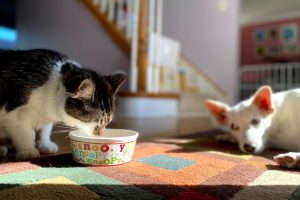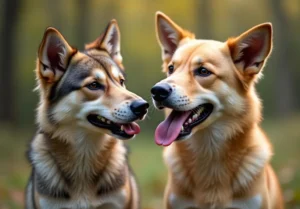Cats are known for their adorable furry paws with distinct markings that resemble mittens. Have you ever wondered why cats have mittens? Let’s explore the fascinating reasons behind this unique feature.
Cats have mittens to aid in their hunting and survival in the wild.
Evolution of cat paws
Have you ever wondered why cats have those adorable mittens on their paws? Well, it all goes back to their evolutionary history. Cats ancestors were wild creatures that roamed various terrains, from dense forests to open grasslands. Having mittens on their paws helped them adapt to different environments and survive in the wild.
One of the key reasons for the evolution of cat paws with mittens was to protect their claws. Cats’ claws are retractable, and by having a padded layer of skin covering them, they can keep their sharp nails hidden when not in use. This not only helps them avoid wearing down their claws but also allows them to move silently and stealthily, a crucial advantage for hunting prey.
Additionally, the furry tufts of hair between a cat’s toes act as insulation. In colder climates, these paw pads help cats retain heat and navigate snowy terrain more easily. Imagine walking barefoot in the snow – having mittens on your paws would definitely make the journey more comfortable!
Unique structure of cat paws
Now let’s take a closer look at the anatomy of a cat’s paw and how its unique structure contributes to their agility, balance, and hunting abilities. Cat paws are truly remarkable in their design, with each part serving a specific function to help them excel in various activities.
Starting from the top, the digital pads on a cat’s paw provide traction and grip, allowing them to climb trees, hunt prey, and move swiftly with precision. The metacarpal and metatarsal pads act as shock absorbers, cushioning their landings and promoting balance during high jumps or quick movements.
The arrangement of toe bones and muscles in a cat’s paw allows for exceptional flexibility and control. This flexibility is essential for climbing, pouncing, and grasping, all crucial skills for a cat’s survival in the wild. Next time you watch your feline friend effortlessly scale a tree or catch a mouse with lightning speed, you’ll appreciate the incredible design of their paws even more.
And here’s an interesting fact: Did you know that cats’ whiskers are not just on their faces? They also have whiskers on the back of their front legs, known as carpal whiskers. These whiskers help cats navigate in tight spaces and judge distances accurately, enhancing their overall coordination and agility. It’s like having an extra set of senses at their disposal!
So, the next time you watch your cat playfully batting at a toy or gracefully leaping onto a windowsill, take a moment to marvel at the intricate design of their paws and how it enables them to be the agile, balanced hunters we know and love.
Role of claws in hunting
Let’s talk about why our feline friends have those adorable mittens on their paws. Cats are natural hunters, and their claws are essential tools for stalking and catching prey. Those retractable little daggers help them climb trees to ambush unsuspecting birds or squirrels. They also play a crucial role in self-defense, allowing cats to fend off attackers or escape sticky situations.
But here’s the twist – those mittens aren’t just there to look cute. They actually serve to protect the claws from wear and tear when not in use. By keeping their claws sheathed most of the time, cats can keep them sharp and ready for action when needed. So, next time you see a kitty stretching out its paws, remember that those mittens are more than just a fashion statement – they are a vital part of a cat’s hunting arsenal.
Cleaning and grooming
Now, let’s delve into another important aspect of why cats have mittens – grooming. Cats are notorious neat freaks, and they take their grooming routine very seriously. Those adorable little mittens play a crucial role in this daily grooming ritual. Cats use their paws to lick and clean themselves, getting rid of dirt, debris, and loose fur.
With their built-in grooming tools – those rough, barbed tongues and dexterous paws – cats can effortlessly maintain their hygiene and health. They use their mittens to clean hard-to-reach spots, such as behind their ears or around their face. So, the next time you catch your kitty licking its paw and running it over its face, remember that those mittens are not just for show – they are essential for keeping your cat looking and feeling its best.
And here’s a pro tip: while mittens are great for grooming, it’s always a good idea to brush your cat regularly to help prevent mats and shedding.
For more information on cat grooming tips, check out this helpful resource from the American Society for the Prevention of Cruelty to Animals: ASPCA Cat Grooming Guide
Behavioral traits associated with mittens
Cats’ mittens, also known as paw pads, play a crucial role in their behavior and communication. When a cat kneads with their mittens, it signifies contentment and relaxation, often reminiscent of kittenhood nursing. This gentle kneading motion is a comforting behavior that indicates a happy and calm feline.
On the flip side , overly aggressive scratching with their mittens might signal stress, frustration, or a need to mark territory. For instance, if a cat is scratching furniture excessively, it could indicate anxiety or lack of proper scratching posts. Providing appropriate outlets for scratching can help alleviate this behavior.
Moreover, observing a cat’s mittens during playtime can give insight into their level of engagement and excitement. If you notice gentle batting or tapping with their mittens, it suggests a playful and happy mood. However, if their mittens are fully extended during play and paired with dilated pupils, it may indicate heightened excitement or predatory behavior.
Understanding a cat’s interactions with their mittens can help decipher their moods and behaviors, enhancing the bond between you and your feline companion. If you notice any sudden changes in their mittens-related behaviors, it may be worth observing closely to address any potential underlying issues promptly.
Cat breeds with unique mittens
Certain cat breeds are celebrated for their distinctive paw patterns, commonly referred to as “mittens.” One such breed known for its unique mittens is the Maine Coon. These large, majestic cats often sport impressively tufted paws, resembling fluffy mittens. Their mittens not only add to their charm but also serve practical purposes by providing insulation in colder climates.
Another breed renowned for their unique paw patterns is the Ragdoll. Ragdolls are known for their striking white mittens, which beautifully contrast with their colored fur. These gentle giants boast large, expressive eyes and velvety fur, making their mittens a standout feature admired by many feline enthusiasts.
Additionally , the Polydactyl cats, also known as Hemingway cats, have an intriguing genetic trait that results in extra toes, giving them a mitten-like appearance. This unique characteristic not only sets them apart visually but also adds an endearing aspect to their overall charm.
Exploring these distinct mittens in various cat breeds showcases the diversity and beauty found within the feline world. Embracing the uniqueness of each cat’s mittens can deepen your appreciation for their individual traits and characteristics.
For more information on cat breeds with unique mittens, you can visit The International Cat Association (TICA)’s website . Their comprehensive breed database can provide detailed insights into various cat breeds and their distinctive features, including unique mittens.
Fun facts about cat mittens
Cat mittens, also known as polydactyl cats, have an extra toe on their paws due to a genetic mutation. This mutation can give them an appearance of having mittens or thumbs on their feet. These extra toes can provide them with better balance and stability, making them great climbers and hunters. Some famous historical figures, like author Ernest Hemingway, were fond of polydactyl cats and even had them as companions.
Here’s a fun fact: Polydactyl cats are sometimes referred to as “Hemingway cats” due to the writer’s affection for them. If you’re a history buff or a literature enthusiast, this unique connection between polydactyl cats and Ernest Hemingway adds an intriguing layer to the fascination with cat mittens.
So, the next time you spot a cat with extra toes resembling mittens, you’ll know it’s not just an adorable quirk but a genetic marvel that sets them apart from their feline counterparts.
Alex, a passionate animal lover, has experience in training and understanding animal behavior. As a proud pet parent to two dogs and three cats, he founded AnimalReport.net to share insights from animal experts and expand his knowledge of the animal kingdom.




